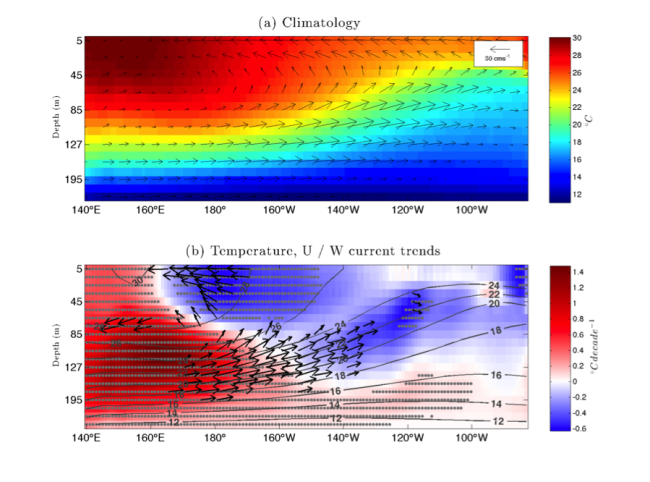Tropical Pacific decadal trends during global warming hiatus
Earth’s surface air temperature has significantly increased over the 20th century, although this overall global warming has been punctuated by periods of weaker/stalled warming or even cooling. The most recent hiatus began in the late 1990s, reigniting the debate with climate change skeptics and confusing the public about the validity of anthropogenic climate change. Recent studies have indicated that shifts in the circulation of the Pacific Ocean and atmosphere have played a key role in the present hiatus’ development.

Longitude/depth cross-sections of temperature (shading) and currents (vectors) averaged over 2.5˚S-2.5˚N for (a) mean climatology (1980-2010) and (b) the linear trends during 1990-2009. Temperature trends (˚C decade-1) are in shading and U/W current trends (cm s-1 decade-1) are black vectors. Gray contours in (b) represent the mean climatology of temperature. Stippling and plotted current vectors indicate significance at 95%.
Thanks to the availability of data from satellite altimetry, Argo floats, and moored buoys in the tropical Pacific, this decadal phase change is the best-observed decadal climate shift in history. Through this lens a study by Amaya et al. (2015) focuses on identifying equatorial Pacific changes during the transition from a non-hiatus period (pre-1999) to the present hiatus period (post-1999) using a combination of reanalysis and observed datasets. Results show increased sea surface heights (SSH) in the west equatorial Pacific over the last two decades associated with increased easterly surface winds. Higher SSH in the west, manifested as a deeper thermocline and subsurface warming, contributed to an intensified west-east pressure gradient that drives the equatorial undercurrent (EUC). The study shows the core of the EUC intensifying at a rate of 6.9 cm s−1 decade−1. Similarly, equatorial upwelling associated with the shallow meridional overturning circulation increased in the central Pacific, shoaling the thermocline and contributing to cooling trends in the mixed layer.
A seasonal dependence is identified in sea surface temperature trends and in subsurface dynamics. For example, the strengthening of the EUC occurs mainly in boreal winter and spring, while in the summer and fall it is weak. An improved dynamical understanding of how the tropical Pacific Ocean transitions into hiatus events, including its seasonal structure, may help to improve future prediction of decadal climate variations.
Seasonality of tropical Pacific decadal trends associated with the 21st century global warming hiatus (Journal of Geophysical Research-Oceans)
1Scripps Institution of Oceanography, University of California, San Diego
2NOAA Pacific Marine Environmental Laboratory
Topics
- Warming Hiatus
- Pacific Ocean
